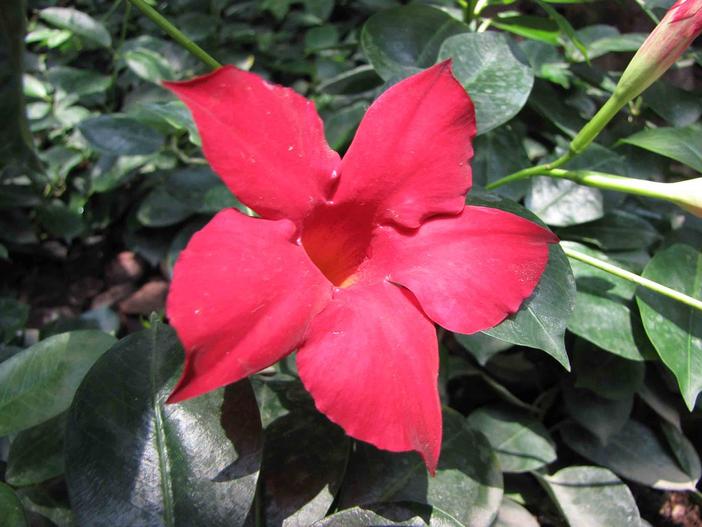Brazilian Jasmine
(Mandevilla sanderi)
Brazilian Jasmine (Mandevilla sanderi)
/
/

阿橋花譜 HQ Flower Guide
CC BY-SA 2.0
Image By:
阿橋花譜 HQ Flower Guide
Recorded By:
Copyright:
CC BY-SA 2.0
Copyright Notice:
Photo by: 阿橋花譜 HQ Flower Guide | License Type: CC BY-SA 2.0 | License URL: https://creativecommons.org/licenses/by-sa/2.0/ | Uploader: 阿橋 KHQ | Publisher: Flickr








































Estimated Native Range
Summary
Mandevilla sanderi, commonly known as Brazilian Jasmine, is an evergreen perennial vine native to the Serra do Mar coastal forests and Atlantic Forest in southeastern Brazil. It typically grows to a height and width of 4-6 feet (1.2-1.8 meters). Brazilian Jasmine is known for its twining habit and its ability to climb with support, showcasing glossy green leaves and a profusion of trumpet-shaped flowers that come in shades of yellow, pink, red, and white, blooming primarily in the warmer months.
This vine is valued for its showy flowers and rapid growth, making it a popular choice for trellises, arbors, and fences in warm climates. It is also used as a potted plant in temperate regions, where it can be moved outdoors during the summer. Brazilian Jasmine requires full sun to partial shade, well-drained soil, and moderate watering, with reduced watering in the winter. It benefits from regular feeding during the growing season. While it can tolerate short periods of drought once established, it is sensitive to frost and must be protected or brought indoors in colder climates. Pruning can be done to maintain shape and encourage bushier growth. It is susceptible to pests such as spider mites and aphids, and overwatering can lead to root rot.CC BY-SA 4.0
This vine is valued for its showy flowers and rapid growth, making it a popular choice for trellises, arbors, and fences in warm climates. It is also used as a potted plant in temperate regions, where it can be moved outdoors during the summer. Brazilian Jasmine requires full sun to partial shade, well-drained soil, and moderate watering, with reduced watering in the winter. It benefits from regular feeding during the growing season. While it can tolerate short periods of drought once established, it is sensitive to frost and must be protected or brought indoors in colder climates. Pruning can be done to maintain shape and encourage bushier growth. It is susceptible to pests such as spider mites and aphids, and overwatering can lead to root rot.CC BY-SA 4.0
Plant Description
- Plant Type: Vine
- Height: 4-6 feet
- Width: 4-6 feet
- Growth Rate: Moderate
- Flower Color: Pink, Red, White
- Flowering Season: Spring, Summer
- Leaf Retention: Evergreen
Growth Requirements
- Sun: Full Sun
- Water: Medium, High
- Drainage: Fast
Common Uses
Bee Garden, Bird Garden, Butterfly Garden, Deer Resistant, Drought Tolerant, Fragrant, Hummingbird Garden, Potted Plant, Showy Flowers
Natural Habitat
Serra do Mar coastal forests and Atlantic Forest in southeastern Brazil
Other Names
Common Names: Brasiljasmin, Bägarranka, Brazilian Jasmine, Mexican Love Vine
Scientific Names: , Mandevilla sanderi, Dipladenia sanderi,
GBIF Accepted Name: Mandevilla sanderi (Hemsl.) Woodson